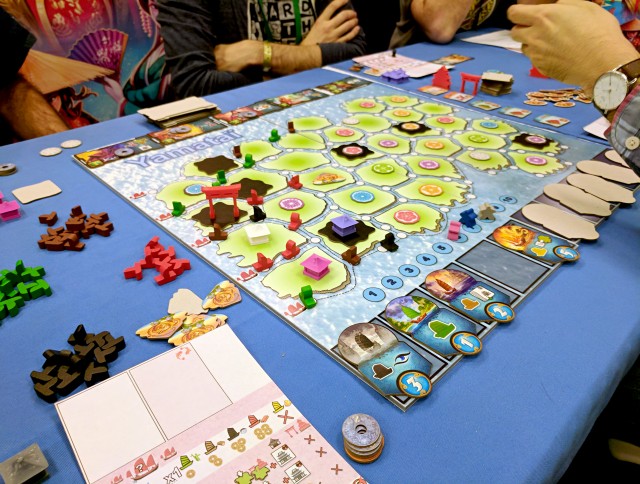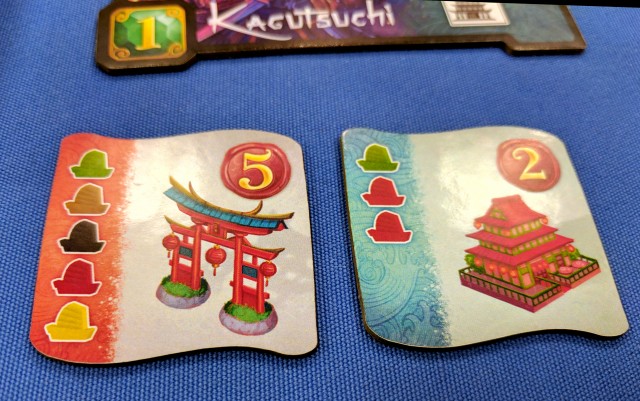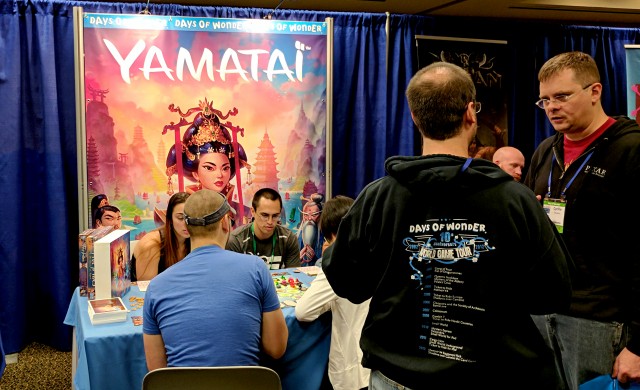There’s an interesting vibe at BGG.CON that separates it from typical conventions. For most publishers, the weekend feels like a hectic sales push and more like a hard-earned victory lap, celebrating the end of the busy period between Gen Con and Essen. But just as all cons are not built the same, neither are all publishers.
Days of Wonder bucks trends by anchoring its product calendar with a single major game targeted for spring release. Rather than capping off the year at BGG.CON, this timing serves Days of Wonder best as an opportunity to kick off next year’s hype. For 2017, some serious groundwork was laid by flying in designer Bruno Cathala and enlisting him for a marathon weekend teaching and playing his latest co-design, Yamataï (sharing credits with Marc Paquien).
 Originally inspired by Cathala’s desire to build a game around Venice and its numerous waterways, the historical Japanese city of Yamataï is used as setting for a shared network of colored ships created by players. Should the proper variety of ships surround an empty island, players can tap into the game’s main source of victory points by constructing a building there.
Originally inspired by Cathala’s desire to build a game around Venice and its numerous waterways, the historical Japanese city of Yamataï is used as setting for a shared network of colored ships created by players. Should the proper variety of ships surround an empty island, players can tap into the game’s main source of victory points by constructing a building there.
The experience seems deeply tactical, rather than strategic, as the ever-expanding network of ships results in an ever-changing board state. New opportunities for high-value construction constantly spring up, but the challenge lies in actually identifying such opportunities. Planning far in advance has the potential for a large payoff, but also comes at considerable risk due to the game’s unpredictable nature.
 As the network of ships expands, a key rule brings the game’s mental puzzle to the fore: players can only place new ships by following a color chain, constraining the players’ ability to set up construction options. Elements of Cathala’s recent Days of Wonder hit, Five Tribes, can be seen here as players perform abstract color manipulation, while remaining cautious against opening up too many opportunities for opponents. As Five Tribes is the publisher’s highest ranked title, one can’t fault Days of Wonder for wanting Cathala to cook up further iterations on this proven formula.
As the network of ships expands, a key rule brings the game’s mental puzzle to the fore: players can only place new ships by following a color chain, constraining the players’ ability to set up construction options. Elements of Cathala’s recent Days of Wonder hit, Five Tribes, can be seen here as players perform abstract color manipulation, while remaining cautious against opening up too many opportunities for opponents. As Five Tribes is the publisher’s highest ranked title, one can’t fault Days of Wonder for wanting Cathala to cook up further iterations on this proven formula.
Another element from a recent Cathala game, Kingdomino, shows up in as Yamataï’’s second major mechanism: variable future turn order based on selection of current turn strength. At the beginning of each turn, players are presented with a market of available roles which dictate several factors: turn income, unique one-turn abilities, and priority in the following turn. This leads to more of that tactical “play with the hand you are dealt” gameplay, where players may select less-than-ideal roles solely in order to take back-to-back (or close to it) turns, short circuiting the board state’s unpredictable evolutions.
 The tactical nature of Yamataï also holds right through to its endgame, where players can trigger final scoring in numerous ways. If any game component is depleted, even down to specific colors of ships, the game will end. For the observant player, this presents opportunities to manipulate just how long a game of Yamataï will be, only driving it towards its conclusion when a victory is in the works. Timing the endgame will be a major element of Yamataï, and I expect it will often catch players off guard.
The tactical nature of Yamataï also holds right through to its endgame, where players can trigger final scoring in numerous ways. If any game component is depleted, even down to specific colors of ships, the game will end. For the observant player, this presents opportunities to manipulate just how long a game of Yamataï will be, only driving it towards its conclusion when a victory is in the works. Timing the endgame will be a major element of Yamataï, and I expect it will often catch players off guard.
Speaking with Cathala after my play, he described how most matches ended with a large number of points on the board from building construction. In my experience, however, players adopted cutthroat strategies that frequently used powers to block building sites and trash boats from the shared network. This forced the ship network to rapidly expand in search of new opportunities, eventually depleting the stock and triggering endgame with average VPs around ⅔ of most matches.
As is to be expected from a full-sized strategy game from Bruno Cathala, there are more moving parts in this game than I was able to characterize in my description of a single play. However, I will eagerly await a look at Yamataï’s completed production next year. Between a strong positive reception from all BGG.CON attendees I spoke to who had the chance to play, plus a visually stunning preview of the game’s final artwork, Yamataï just might be shaping up to be the total package.
Comments
No comments yet! Be the first!